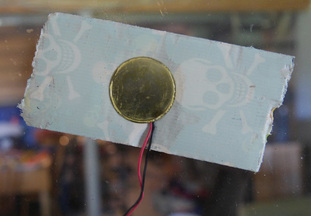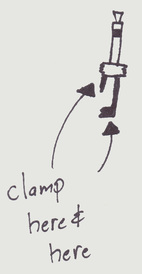
There are many different ways to capture sound. My hero Thomas Edison’s early recorders would capture sound on tinfoil and wax. Today’s microphones take vibrations from the air and turn them into an audio signal. You can make your own microphone in many different ways. The easiest microphone can be made by just plugging headphones into a “microphone in” jack on some audio equipment. Though the sound won’t be that great.
We’re going to make a microphone that takes vibrations from an object and makes them into an audio signal, which is perfect for listening through a window to the conversation inside a room. The key to the “glass ear” is a piezo buzzer, which is like a speaker but it creates vibrations in an object instead of the air. Regular speakers vibrate air, piezo buzzers vibrate objects, get it? These can be found in old toys, alarm clocks, stopwatches, stud finders, and some musical greeting cards; anything that bleeps, beeps, buzzes, squeals, or chirps probably uses a piezo buzzer (also known as piezo element). If you can’t find a piezo buzzer to reuse you can always just go to an electronics store or online and buy one for a few bucks. I used one of these to make
my “Canned Music” microphone too. Piezo buzzers are fun to play with, cheap, and have a thousand different uses, so keep all the piezo buzzers you find for future projects. Taping one to anything makes it a musical instrument. Experiment and have some fun!
We’re going to make a microphone that takes vibrations from an object and makes them into an audio signal, which is perfect for listening through a window to the conversation inside a room. The key to the “glass ear” is a piezo buzzer, which is like a speaker but it creates vibrations in an object instead of the air. Regular speakers vibrate air, piezo buzzers vibrate objects, get it? These can be found in old toys, alarm clocks, stopwatches, stud finders, and some musical greeting cards; anything that bleeps, beeps, buzzes, squeals, or chirps probably uses a piezo buzzer (also known as piezo element). If you can’t find a piezo buzzer to reuse you can always just go to an electronics store or online and buy one for a few bucks. I used one of these to make
my “Canned Music” microphone too. Piezo buzzers are fun to play with, cheap, and have a thousand different uses, so keep all the piezo buzzers you find for future projects. Taping one to anything makes it a musical instrument. Experiment and have some fun!
Materials: *piezo buzzer
*old headphones $ Tools: *portable cassette player
*electrical tape $ *wire cutters $ *wire strippers Steps: |
|
1. Sometimes piezo buzzers are surrounded in a plastic housing, use wire cutters to cut the plastic away. Start by cutting at the hole in the center of the plastic housing and work your way outwards. Be careful, the piezo buzzer and the wires are fragile. So are your fingers! Get some help from an adult.
2. Cut your headphone’s wire near where the wire splits and goes to each headphone - you are going to use the end that has the 1/8th inch plug. On the cut end, strip the plastic coating away to expose each wire.
3. Twist together each one of the wires from the piezo buzzer to the wires from the headphones. Make sure that your twisted wires don’t touch each other. Use electrical tape to cover each connection completely.
4. Tape the flat side of your piezo buzzer against a window in a room that you want to eavesdrop on. It’s best to do this near the corner of the window to keep your microphone hidden, but not completely in a corner otherwise you won’t pick up any vibrations (sound). The “glass ear” works best on single-pane windows, and won’t work as well on a window that is double-pane (has two pieces of glass).
5. Plug your headphone jack into the “microphone in” on your portable cassette player or stereo system. Start with the volume very low, and then raise it as needed. To test, tap gently on the glass with the volume low.
2. Cut your headphone’s wire near where the wire splits and goes to each headphone - you are going to use the end that has the 1/8th inch plug. On the cut end, strip the plastic coating away to expose each wire.
3. Twist together each one of the wires from the piezo buzzer to the wires from the headphones. Make sure that your twisted wires don’t touch each other. Use electrical tape to cover each connection completely.
4. Tape the flat side of your piezo buzzer against a window in a room that you want to eavesdrop on. It’s best to do this near the corner of the window to keep your microphone hidden, but not completely in a corner otherwise you won’t pick up any vibrations (sound). The “glass ear” works best on single-pane windows, and won’t work as well on a window that is double-pane (has two pieces of glass).
5. Plug your headphone jack into the “microphone in” on your portable cassette player or stereo system. Start with the volume very low, and then raise it as needed. To test, tap gently on the glass with the volume low.
Optional:

*1/8” male audio plug
* 2 alligator clip jumper wires (color doesn’t matter)
Using a plug from some cheap headphones can cause a lot of static and can easily become disconnected. If you want high
quality audio, use a 1/8” male mono plug and 2 alligator jumper wires. If you’re going to use the 1/8” male audio plug, simply use the alligator clips to connect both wires from the piezo buzzer to the two separate metal arms (one long, one short) on the male audio plug. Turn the volume down low on your portable cassette player, stereo system, or amp and start recording. Plug the “glass ear” into the amp and gently tap near the piezo buzzer to test if it’s working. Slowly increase the volume to a comfortable level. These can get pretty loud.
* 2 alligator clip jumper wires (color doesn’t matter)
Using a plug from some cheap headphones can cause a lot of static and can easily become disconnected. If you want high
quality audio, use a 1/8” male mono plug and 2 alligator jumper wires. If you’re going to use the 1/8” male audio plug, simply use the alligator clips to connect both wires from the piezo buzzer to the two separate metal arms (one long, one short) on the male audio plug. Turn the volume down low on your portable cassette player, stereo system, or amp and start recording. Plug the “glass ear” into the amp and gently tap near the piezo buzzer to test if it’s working. Slowly increase the volume to a comfortable level. These can get pretty loud.


